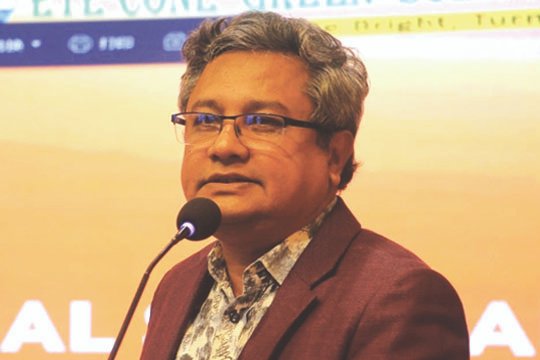
Electric vehicles may promise a cleaner future, but for Bangladesh, the road to that future must be paved with realism and local readiness. "Start small, build capacity, and don’t rush into mass adoption," says Professor Dr. Md. Ziaur Rahman Khan of BUET, who believes launching electric public transport in Dhaka should begin with a pilot, not a fleet.
In an in-depth interview with Mollah Amzad Hossain, Editor of Energy & Power, the seasoned energy expert also warns that battery-powered rickshaws could spiral into a serious safety and infrastructure crisis if left unregulated. He discusses why a measured, locally-driven approach is vital for the success of EVs in Bangladesh—and how policy gaps, political interests, and lack of technical preparedness could otherwise derail it.
These were the key observations made by Professor Dr. Md. Ziaur Rahman Khan, from the Department of Electrical and Electronic Engineering at Bangladesh University of Engineering and Technology (BUET), during a conversation with Mollah Amzad Hossain, Editor of Energy & Power.
How would you assess the current state of Bangladesh’s power and energy sector? Currently, 55% of the electricity and energy supply depends on imports. With rising prices of crude oil and LNG due to the Israel-Iran conflict, what should Bangladesh do?
Given our increasing dependence on imported fuel, long-term purchase agreements for oil and LNG could have helped mitigate such wartime supply shocks. But now, nothing can be done in that regard. Instead, the focus must be on monitoring global prices and ensuring energy efficiency and conservation domestically, starting with the public sector, where energy waste remains significant. At the same time, an environment must be created to encourage greater private sector investment in energy-efficient technologies.
I don’t support rationing or load shedding as an emergency measure to cut imports. That would disproportionately affect rural consumers, creating discontent and unrest, something that would not be favorable for the government.
The government finalized its Renewable Energy Policy 2025, aiming to produce 20% of electricity from renewables by 2030 and 30% by 2040. Is this realistically achievable?
You can’t achieve meaningful change by force. Previously, there was a target of generating 10% of electricity from renewables by 2020—but that wasn’t met. Now, the new policy sets a 20% target by 2030 and a 30% target by 2040.
In my view, we must focus on creating an investment-friendly environment and offering proper incentives to achieve these targets. Under this new policy, SREDA has been tasked with developing a “Renewable Purchase Obligation” guideline for utility companies. But again, results won’t come from pressure alone.
Instead, the government should develop land and grid infrastructure for solar projects, then invite bids from investors. That would make target achievement more realistic and efficient.
After canceling 37 LOIs (Letters of Intent) under the caretaker government, the authorities have invited bids for 52 renewable energy projects, but received very little response due to the absence of implementation agreements. How do you assess this situation?
On the canceled LOIs, many of them were issued under the previous government without competitive bidding. In several cases, corruption occurred in tariff setting and project selection. So canceling them was justified.
However, the issue now is that the government updated its renewable energy policy to attract private investment, but still, there was low interest in the 52 tendered projects. Why? Because without investment return guarantees, reputable companies will not participate, nor will financing institutions provide loans. The Implementation Agreement provides that guarantee.
In these new tenders, the Implementation Agreement was excluded, which discouraged participation from credible domestic and international players.
In my view, the government should build solar parks with developed land and transmission infrastructure, and then invite tenders that include Implementation Agreements. This would allow solar power to be procured at much lower tariffs. The government can also seek investment support from the World Bank and ADB for this.
If done right, significant progress in renewable energy capacity can be achieved quickly.
The government has taken an initiative to gradually electrify public transport to reduce greenhouse gas emissions and air pollution. As part of this, electric buses are expected to be launched in Dhaka by December. How do you see this initiative?
Look, the government can definitely implement this initiative in collaboration with development partners. Suppose electric buses in Dhaka are launched through a public sector agency like BRTC. That would be a good move. However, instead of launching 40-50 buses at once, it would be better to begin with a pilot project of 10 buses. This would help us build local technical expertise for maintenance. Additionally, instead of importing electric buses, initiatives should be taken to manufacture them locally through public and private sector investment. That would make the transition to electric buses more sustainable. We must remember that to make such projects sustainable, we need to build our own capacity.
What do you see as the biggest challenge in gradually electrifying public transport? What kind of roadmap should the government follow?
In most countries, public transport is state-controlled. But in Bangladesh, this sector is controlled by political interests. As a result, even though AC buses were launched on some routes, they couldn’t be sustained. The attempt to introduce a franchise-based route system also failed. So replacing the current system with electric buses won’t be easy. Technically, it’s doable. But the main barrier to modernizing public transport in a people-centric way is the politics of the transport sector. That’s why implementing electric public transport in Bangladesh won’t be easy.
Bangladesh currently lacks a robust EV charging infrastructure. What kind of policies should be adopted to scale this up quickly? Do you see potential in solar-powered charging stations?
At present, the limited number of four-wheeler EVs in the country doesn’t require quick charging. Most users can drive during the day and charge at home at night. However, if EV use grows and inter-city travel starts, then quick charging stations will be necessary. For public transport in Dhaka, BRTC depots can be used for charging. For three-wheelers, solar charging stations combined with net metering could be a good solution. It would also reduce charging costs. Such solar charging stations are already in operation in places like Manikganj, Khulna, and Rajshahi.
To boost EV adoption, the government has recently issued an SRO reducing import duties on key components like e-bikes, lithium, and graphene batteries from 60–80% to 1%. How would you evaluate this step?
It’s a good decision. If this tax benefit is used to locally produce e-bikes and lithium/graphene batteries, it will help lower costs. However, it’s important to monitor this carefully. We must ensure that these tax benefits are not misused.
What kind of policies should the government adopt to increase EV usage in Bangladesh?
Although EV use is growing rapidly worldwide, I don’t think there will be a large market in Bangladesh for now. Users here typically buy internal combustion engine cars priced at BDT 3–4 million. However, even after duty reductions, Chinese EVs cost BDT 6–7 million, and Japanese EVs may cost BDT 8–9 million. So to make EVs popular, significant duty reductions and low-interest loans, along with other incentives, are necessary. Above all, we need to build our own technical capacity. Otherwise, even if EV production begins in Bangladesh, I don’t see it achieving great success.
Battery-powered rickshaws—often referred to as the “Tesla of Bengal”—have created new opportunities in transportation but also worsened road safety issues. What should be done to register and regulate them?
Ensuring road safety requires bringing battery rickshaws under strict regulation. Their fitness must be ensured. Drivers should receive training and a license. Ideally, BRTA should handle this. But there are plans to place registration and control under local government, and I doubt that will succeed. Unless this sector is quickly brought under regulation, it will create serious problems. The battery rickshaw sector involves large sums of unofficial money and extortion. It’s hard to say how successful the government will be in regulating it while ignoring those vested interests.
These rickshaws have created a new challenge in rural and urban power distribution. It’s said that late-night charging significantly increases the load, causing power outages in Dhaka and elsewhere. How do you assess this technically?
Multiple factors are involved. It’s not entirely accurate to say charging suddenly spikes the load. Distribution utilities know when and where loads increase due to charging. Three-wheeler batteries are charged by converting AC to DC power, which creates harmonics—i.e., high-frequency currents. This causes transformers to overheat and leads to outages.
In a study conducted in a battery charging zone in Khulna, we found that a 250 kVA transformer starts overheating and becomes overloaded when the load hits 190 kVA, leading to power disruptions.
To tackle this, the quality of charging units must be ensured. The ones currently used are substandard. There is no requirement for BSTI certification for importing, manufacturing, or using them. Before this problem worsens, we must ensure the use of quality-certified chargers to avoid a major harmonic-related crisis.
Downloan Interview AS PDS/userfiles/EP_23_1_Interview.pdf



